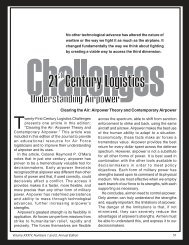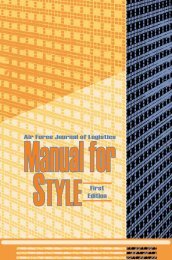Vol 32 No 4 - AF Logistics Management Agency
Vol 32 No 4 - AF Logistics Management Agency
Vol 32 No 4 - AF Logistics Management Agency
You also want an ePaper? Increase the reach of your titles
YUMPU automatically turns print PDFs into web optimized ePapers that Google loves.
<strong>32</strong><br />
...<br />
SPOD<br />
MCT<br />
LR 4<br />
+++<br />
ARFOR<br />
++<br />
TSC<br />
+<br />
ESC<br />
X<br />
SUST (TO)<br />
II<br />
MCB<br />
MSR<br />
X<br />
AVN<br />
TTOE<br />
...<br />
MCT<br />
+++<br />
JFLCC<br />
...<br />
Theater Distribution<br />
Center MCT<br />
ATOC<br />
... APOD<br />
MCT<br />
...<br />
MCT<br />
JDDOC or<br />
JDDOC FWD<br />
...<br />
AMD<br />
X<br />
(TD)<br />
SUST MCT<br />
...<br />
Distribution MCT<br />
Hub<br />
II<br />
MCB<br />
CSC CSC<br />
...<br />
MCT<br />
100 miles 200 miles<br />
required to operate a Joint theater distribution system. Starting<br />
at the beginning with requirements definition outside of division<br />
capabilities (lower right of Figure 2), the division staff<br />
coordinates its movement requirements with the Corps Staff in<br />
the event that the division MCT does not have the assets<br />
available to it for commitment. The MCT forwards the request<br />
to the area MCT, normally collocated with a sustainment<br />
brigade, for support. The MCT with a support relationship to the<br />
sustainment brigade has the ability to commit its transportation<br />
assets and provide support to other MCTs in its area of operation.<br />
Requests for transportation that are above the MCT’s capacity<br />
should be forwarded to the MCB for routing to other MCTs for<br />
support, or forwarded to the JDDOC FWD. At the division level,<br />
the aviation unit assigned to the division can identify assets for<br />
the division MCT to commit for movement requests. MCTs can<br />
also push cargo to Army aviation units for movement on<br />
previously scheduled airlift missions or regularly scheduled lift<br />
missions (channel missions) for space available movements. For<br />
successful use of channel missions, the MCTs require visibility<br />
over all cargo requiring movement at the aerial port so the Joint<br />
MCT can better prioritize all cargo for air movement—not just<br />
Army cargo.<br />
One area not represented in the figure is the continuous<br />
coordination between MCTs. Movement requirements are not<br />
all met with formal movement requests, as shown in Figure 2.<br />
JFACC<br />
Airlift Wing<br />
<strong>AF</strong>FOR<br />
ATOC<br />
...<br />
MCT<br />
APOD<br />
X<br />
SUST<br />
(Div)<br />
...<br />
MCT<br />
++<br />
Div Main CP<br />
G4 DTO<br />
Coordination<br />
Direct Support<br />
TACON<br />
OPCON<br />
X<br />
AVN<br />
...<br />
DIV MCT<br />
200 miles<br />
LR 3 LR 2 LR 1<br />
Figure 1. Recommended Organizational Relationships 29<br />
X<br />
CSB<br />
X<br />
FIRES<br />
X<br />
BFSB<br />
MSR<br />
BCT<br />
X<br />
BCT<br />
X<br />
BCT<br />
X<br />
BCT<br />
X<br />
BCT<br />
X<br />
BCT<br />
Some requirements are met by pushing smaller amounts of cargo<br />
to a port or terminal for movement on air channel missions or on<br />
a space available basis.<br />
Above the division level, the Army Forces Component may<br />
designate some aviation assets to support the distribution system.<br />
The JDDOC FWD should have responsibility for managing these<br />
resources in the same manner as Air Force lift assets. If an MCB<br />
cannot support a request from one of its MCTs, the request moves<br />
to the JDDOC FWD. The JDDOC FWD reviews and validates the<br />
request and forwards the request to the appropriate mode for<br />
execution through either the AMD or the ESC. If the JDDOC FWD<br />
does not have the assets available for commitment, the request<br />
is forwarded to the JDDOC. If the JDDOC determines that ground<br />
movement will best support the requirement, the commitment is<br />
sent to the TSC. If it determines that airlift best supports the<br />
requirement, the commitment is sent to the AMD or to<br />
USTRANSCOM for support.<br />
With the management of the request process conducted by a<br />
single command and control structure with Joint capabilities, the<br />
Services can concentrate on meeting the requirements given to<br />
them to execute. Additionally, the parochial concerns of the<br />
Services about the fairness of a system managed by one Service<br />
or another can be overcome. The changes also ensure that the<br />
tactical units are able to influence the Joint theater distribution<br />
system to the level they require to meet their requirements, as<br />
Air Force Journal of <strong>Logistics</strong>





